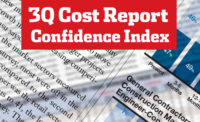This year marks the eighth year of a recovery from the deep industry recession that was sparked by the financial collapse of September 2008, the third-longest industry recovery on record. And there is still gas in the tank, according to industry executives. But these same execs are hedging their bets beyond 2018.
The near-term optimism, blunted by a longer-term market concern, can be seen in the results of the ENR Construction Industry Confidence Index survey. The CICI fell six points, to 66, in the third quarter. However, of the 257 executives of large construction and design firms responding to the survey, most believe market growth will continue at least through the end of 2018.
But beyond that, the execs are less optimistic. The decline in the CICI rating is a reflection of long-term market concerns. For example, only 15% think it will be in decline in 12 to 18 months, compared to 37% who say it still will be in growth mode. But, in three years, 31% expect a market decline, compared to 24% who believe it still will be growing.
The CICI measures executive sentiment about the current market and where it will be in the next three to six months and over a 12- to 18-month period. A reading above 50 indicates a growing market.
The index is based on responses to surveys sent out between Aug. 24 and Sept. 26 to more than 6,000 U.S. firms on ENR’s lists of leading general contractors, subcontractors and design firms.
View the full ENR 2017 3Q Cost Report PDF
CFMA Sees Short-Term Optimism
The soon-to-be-released results of the latest Confindex survey from the Construction Financial Management Association, Princeton, N.J., similarly shows that execs believe the market and economy will remain strong through the end of 2018.
Each quarter, CFMA polls 200 CFOs from general and civil contractors and subs. The CFMA Confindex is based on four separate financial and market components, each rated on a scale of one to 200. A rating of 100 indicates a stable market; higher ratings show market growth is anticipated.
“The overall Confindex rose from 123 in the second quarter to 124 in the current quarter,” says Stuart Binstock, CEO of CFMA. Three of the four components of the Confindex also rose in the third quarter, after falling in the second quarter, he notes.
The “general business conditions” component rose four points, to 128, the “current conditions” component was up two points to 128 and the “year-ahead outlook” rose one point to 120, Binstock says. The Confindex “financial conditions” component fell a modest two points, to 121, he notes.
Part of the optimism about the near-term market is that lenders continue to be willing to finance projects. In the current quarter, ENR asked whether clients’ access to capital for projects is getting easier or tougher than it was six months ago.
Two-thirds of respondents said lending criteria is unchanged from the beginning of the year, but 19.4% said access to project financing was actually easier now than at the beginning of the year, while only 13.3% said lending was tightening.
The values of properties under development are rising quickly, leading to lenders being more willing to front money to developers, says Anirban Basu, CEO of economic consultant Sage Policy Group Inc., Baltimore. “Lenders are sitting on a great deal of cash to lend and, because asset values are rising, there is more value in the collateral underlying these loans.”
The growth in the market has begun to boost many firms’ bottom lines. The ENR CICI survey asked participants how their current profit margins compare to a year ago. While 49.8% said profit margins were about the same, 31.9% said profits were up since last year.
However, many firms also said that competition also is rising. In the CICI survey, 28.0% of the respondents said competition was actually increasing, despite the amount of work available. “Many contractors now are more willing to move into new markets or bid on larger projects in a growth market, increasing competition,” Basu says.
Among the market sectors measured by the CICI survey, most were off in the third quarter compared to the second quarter. The big loser was the retail sector. It is down two points to 41, the lowest-rated sector in the survey. The decline is spurred by increasing store closures among major retail chains as customers continue to move to online shopping.
On the other hand, the distribution and warehouse sector advanced five points to 74, the highest-rated in the survey, caused in part by internet merchants scrambling to build fulfillment centers to service their customers.
Another sector that saw a major hit in this quarter was transportation. The sector dropped nine points to a 69 rating as many industry execs are becoming more wary of the administration’s infrastructure spending plans. Further, the survey closed before Sept. 28, when President Trump appeared to pull back his support of private financing of infrastructure funding.
While the current market is doing well, many execs expressed a growing sense of unease about the political gridlock in Washington. This frustration was summed up by the president of one mid-sized contractor: “All the talk about infrastructure does nothing for the business. We need some comprehensive action.”




Post a comment to this article
Report Abusive Comment